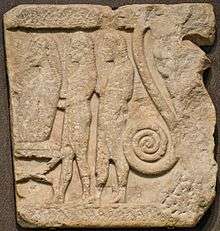Kabeiroi
| Bu sayfa, başka dilde bir Vikipedi'den çevrilmektedir. Siz de yardım etmek istiyorsanız veya çeviri yarıda kalmışsa, çalışmaya katılan kişilerle veya çeviri grubu ile iletişime geçip, sayfanın durumunu onlara sorabilirsiniz. Sayfanın geçmişine baktığınızda, sayfa üzerinde çalışma yapanları görebilirsiniz. |
Yunan mitolojisi, Kabeiroi (Cabiri, Cabeiri,[1] ya da Kabiri; Eski Yunanca: Κάβειροι)
Kaynakça
- ↑ Kabiri is the transliteration used in John Raffan's translation of Walter Burkert, Greek Religion (Harvard University Press, 1985), and in most academic discourse.
Kaynaklar
- Burkert, Walter (1985). Greek Religion, Sect. VI.1.3 "The Kabeiroi and Samothrace",Harvard University Press. ISBN 0-674-36281-0.
- Ferguson, John (1970). The Religions of the Roman Empire (pp. 122–123). London: Thames and Hudson. ISBN 0-8014-9311-0.
- Hammond, N.G.L. & Scullard, H.H. (Eds.) (1970). The Oxford Classical Dictionary (p. 186). Oxford: Oxford University Press. ISBN 0-19-869117-3.
- Kerenyi, Karl (1951). Gods of the Greeks. Thames & Hudson. ISBN 0-500-27048-1.
- Bernard Evslin. Gods, Demigods and Demons: A Handbook of Greek Mythology. ISBN 978-1-84511-321-6.
- Michael B. Cosmopoulos. Greek Mysteries: The Archaeology and Ritual of Ancient Greek Secret Cults. ISBN 0-415-24873-6.
- The Odd Fellows Improved Manual, A.B Grosh 1871 p. 91
- Richard Noll, Mysteria: Jung and the Ancient Mysteries (unpublished page proofs, 1994)
This article is issued from Vikipedi - version of the 7/16/2016. The text is available under the Creative Commons Attribution/Share Alike but additional terms may apply for the media files.
